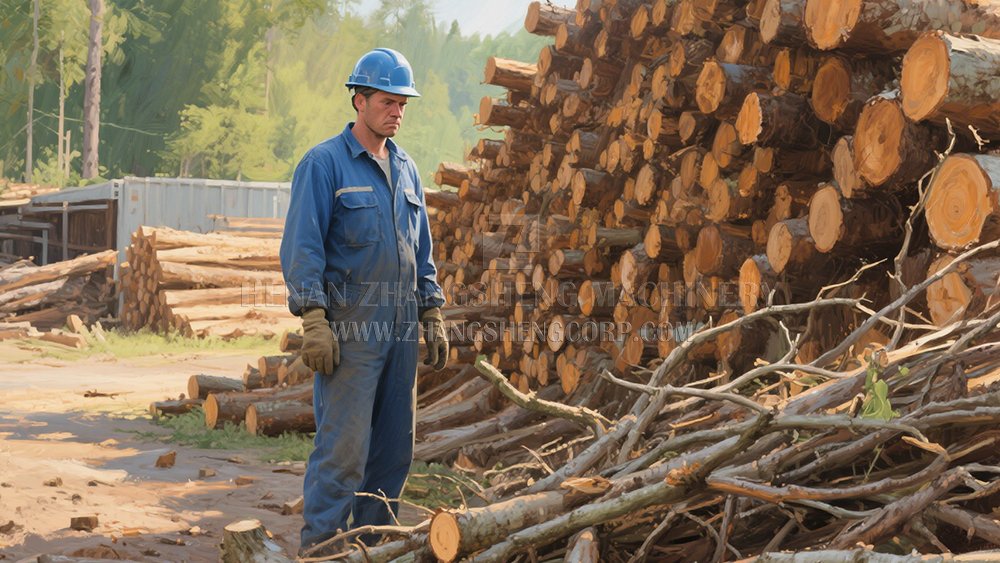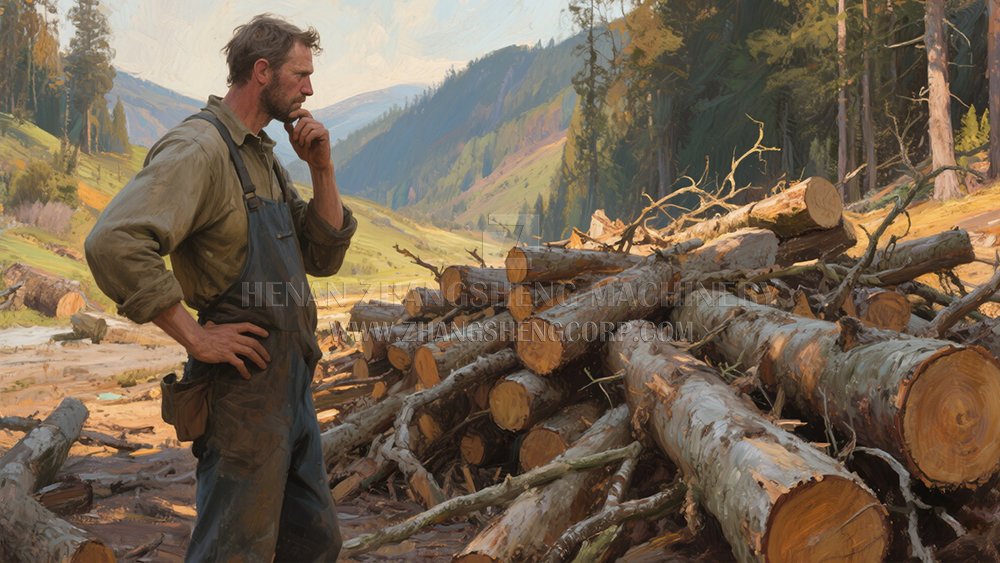You're looking at a pile of branches and wondering how quickly a wood chipper can turn it into useful chips. You might even have a larger log in mind. The crucial question is: how much raw power does one of these machines really have?
Wood chipper machines possess significant power, typically ranging from 150 horsepower (HP) to over 300 HP, enabling them to efficiently process various sizes of wood. This power is crucial for cutting through dense materials and maintaining high output rates, tailored for professional and industrial use.
My experience in the wood recycling equipment manufacturing industry for 22 years has shown me that power is at the heart of a chipper's performance. At Zhangsheng, we design our machines to handle demanding tasks for international markets. Let's delve into what makes these machines so powerful.
How big of a tree can a chipper take?
You have a large branch or even a small tree that needs to be processed. The question on your mind is, can a wood chipper really handle something that big, or is it only for small twigs and branches?
A modern wood chipper, especially those designed for commercial use, can take surprisingly large pieces of wood. Our machines can process logs and branches with diameters ranging from 12 inches (300mm) up to 16 inches (400mm), depending on the specific model and its design.

At Zhangsheng, we understand that our customers, from forestry and logging companies to waste management centers [B2B Target Customers], often deal with substantial woody material. That's why our wood chippers are built to accommodate considerable sizes. For instance, one of our models has a maximum infeed size diameter of 300mm (12 inches). Another can handle up to 350mm (14 inches) in diameter. For even larger material, we have models with a 400mm x 480mm (16 inch) maximum infeed size diameter and a large 750mm x 700mm maximum inlet size. The actual maximum size a chipper can take is determined by the size of its infeed opening and the power of its engine. Our machines feature hydraulic forced feeding systems that are designed to handle different material diameters easily. They adjust the speed to ensure optimal performance and higher output. This means that even with irregular-shaped branches or logs, the material is efficiently pulled into the cutting mechanism. We also equip our chippers with a smart feeding system that monitors the chipping load in real-time. If there's too much material or a blockage starts to occur, the system automatically adjusts the feed speed or stops the feed altogether. This protects the machine from damage and ensures smooth operation. My colleagues and I have seen firsthand how these systems allow our chippers to tackle large volumes of wood waste, turning what might seem like an unmanageable pile into consistent wood chips. The hardness and exact size of the raw wood can influence the output data, but the machines are designed to adapt.
Factors Determining Maximum Wood Size
| Factor | Description |
|---|---|
| Infeed Opening Size | The physical dimensions of the opening where the wood enters the chipper. Our models range from 300mm (12 inch) up to 400mm x 480mm (16 inch) in diameter capacity. |
| Engine Horsepower | More powerful engines can drive the cutting mechanism through denser, larger pieces of wood more effectively. |
| Feeding Mechanism | Hydraulic forced feeding systems ensure large, irregular material is consistently pulled into the chipper, preventing jams and maximizing throughput. |
| Cutting Drum/Blades | The size and robustness of the cutting drum and the number and quality of the blades determine the machine's ability to process large diameters. Our drums can be up to 800mm x 1015mm. |
| Smart Feeding System | This system monitors the chipping load and prevents blockages, allowing the chipper to process large volumes without interruption, even if the material is challenging. |
So, yes, a well-designed wood chipper can handle a significant amount of material, much larger than many people might initially expect.
How much HP does a wood chipper need?
You're considering investing in a wood chipper, and you see various models with different horsepower ratings. You might wonder: what's the right amount of power, and how much HP does a wood chipper truly need to be effective for your specific tasks?
The horsepower a wood chipper needs depends heavily on the size and type of wood it will process, as well as the desired output capacity. Commercial wood chippers typically range from 150 HP to over 300 HP to effectively handle large volumes of woody material.

As a manufacturer with 22 years of experience in wood recycling equipment, I can tell you that horsepower is a direct indicator of a chipper's capability. For lighter duty tasks, such as processing smaller branches, a less powerful machine might suffice. However, for the demanding work of forestry companies, large farms, or recycling centers [B2B Target Customers] that deal with substantial logs and branches, higher horsepower is essential. Our wood chippers come with robust diesel engines, offering various power levels. For example, one model features a Cummins engine delivering 110 KW (150 HP). Another model, equipped with a Huadong diesel engine, boasts 145 KW (197 HP). We also offer models with even higher power, such as 336 HP. The choice of engine brands is also important for our international customers. We offer not only high-quality Chinese diesel engines but also globally renowned brands like Cummins and Perkins, making parts and maintenance easier to access worldwide. The higher horsepower allows the chipper to maintain the maximum rotation speed of the cutting drum, often 2200 rpm, even when feeding large, dense material. This sustained power ensures consistent chip production and prevents the machine from bogging down. It's not just about the raw HP, though. Features like our intelligent feeding system and user-friendly controls work in tandem with the engine to optimize performance. This smart system monitors the load and adjusts the feed speed to prevent blockages, ensuring the machine operates smoothly and efficiently regardless of the wood type or size.
Factors Influencing HP Requirements
| Factor | Impact on HP Needs |
|---|---|
| Material Diameter | Larger diameter logs and branches require significantly more HP to cut efficiently. A 16-inch capacity chipper will need far more power than a smaller one. |
| Wood Hardness | Denser, harder wood species (e.g., oak, maple) demand greater HP than softer woods (e.g., pine, poplar) to achieve consistent throughput. Our machines handle diverse wood types. |
| Desired Throughput | If you need to process a large volume of material quickly, a higher HP machine will maintain efficiency. This is crucial for commercial operations like biomass energy companies [B2B Target Customers]. |
| Continuous Operation | For extended periods of work without interruptions, sufficient HP prevents the engine from overworking and allows features like the smart feeding system to operate optimally, preventing blockages. |
| Engine Quality & Type | High-quality diesel engines from brands like Cummins, Perkins, or Huadong provide reliable power and torque, essential for heavy-duty chipping. |
Ultimately, the required HP is a balance between the size of the material, the desired output, and the overall efficiency you expect from your wood chipper.
What is the power of a wood chipper?
When we talk about the "power" of a wood chipper, it's more than just its horsepower number. What does that power actually translate into in terms of capabilities and operational efficiency?
The power of a wood chipper translates into its capacity to efficiently process large, dense woody materials, its ability to maintain high cutting speeds, and its overall reliability in demanding environments. This power is manifested through its robust engine, advanced feeding systems, and durable cutting components.
At Zhangsheng, our machines are designed to harness their power for maximum productivity and longevity, reflecting our 22 years in the industry. For example, our chippers are driven by powerful diesel engines ranging from 150 HP to 336 HP. This engine power directly drives the cutting drum, which can achieve a maximum rotation speed of 2200 rpm. This high rotational speed, combined with multiple blades on the drum (e.g., 6 or 9 blades), ensures efficient and consistent cutting of wood into chips. But the power isn't just in the cutting. Our hydraulic forced feeding systems ensure a continuous and adjustable flow of material into the chipper, optimizing performance based on different material diameters. The smart feeding system is a crucial component that prevents blockages by monitoring the chipping load and automatically adjusting the feed speed. This intelligent use of power means that even when tackling hard raw wood that affects output data, the machine operates smoothly and reliably. The power of a wood chipper also extends to its user-friendly operation, with intuitive control levers for roller functions (forward, reverse, stop) and a smart control panel that displays key working conditions like oil level and water temperature. This allows operators to monitor the machine's health and prevent issues, ensuring maximum uptime. This comprehensive approach to power allows our wood chippers to handle complex operating environments, making them ideal for customers seeking "Made in China + International Quality" [Summary of Zhangsheng].
Aspects of Wood Chipper Power
| Aspect of Power | How It Manifests in a Wood Chipper |
|---|---|
| Raw Force | Provided by the high-horsepower diesel engines (150 HP to 336 HP), allowing the machine to cut through dense wood and process large diameters efficiently. |
| Cutting Efficiency | Achieved through the high rotational speed of the cutting drum (2200 rpm) and the design and number of blades, ensuring clean and consistent chipping. |
| Throughput Control | Enabled by hydraulic forced feeding systems that adjust to material diameter and smart feeding systems that prevent blockages, ensuring a steady, high volume of processed material. |
| Operational Reliability | Supported by robust construction, quality components, and smart control panels that monitor machine health, minimizing downtime and maximizing consistent output over long periods. |
| Adaptability | The ability to handle various types and sizes of wood, from diverse raw wood hardness to large logs, thanks to the integrated power of its components and intelligent systems. |
So, the power of a wood chipper is a multi-faceted capability that defines its efficiency, reliability, and overall performance in real-world applications.
Conclusion
Wood chippers are incredibly powerful, capable of processing large branches up to 16 inches in diameter. Their horsepower, ranging from 150 HP to over 300 HP, combined with smart feeding systems, ensures efficient and reliable operation.


